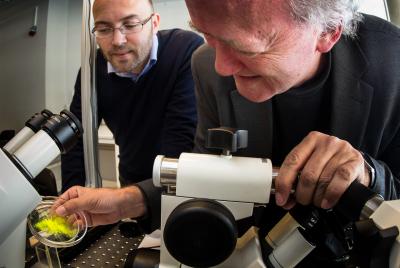Breakthrough method for making Janus or patchy capsules

Paul Dommersnes, left, from the University of Paris, Diderot, and Jon Otto Fossum, from the Norwegian University of Science and Technology, were among the team that has come up with a novel way to create patchy capsules. Credit: Photo: Per Harold Olsen
Hollow capsules that have a selectively permeable shell are promising candidates as tiny containers for molecules, particles or bubbles, and are becoming increasingly important in a wide variety of applications. But making these kinds of capsules with more than one kind of substance on their shells has been challenging – until now.
In a article in the latest edition of Nature Communications, NTNU researcher Jon Otto Fossum and Paul Dommersnes from the University of Paris, Diderot, were part of a team that showed that both Janus and more advanced patchy capsules can be assembled by combining electro-coalescence and electro-hydrodynamic flow in leaky dielectric emulsion drops. This technique can be used with any type of insulating or weakly conductive particles.
Their work is the realization of one possible direction foreseen by the same researchers in a publication in Nature Communications in 2013.
Hollow capsules with two or more substances on their surface are able to organize themselves in specific ways, which means they could be used to grow human skin or other body tissues, or to make porous tissues and composites. They can also be used to transport a variety of substances and release them in specific environments.
Janus capsules, named for the two-faced Roman god, have just two different substances in their shells. They are a sub-group of patchy capsules, which can have more than two different substances in their shells. The researchers were able to make both Janus capsules, with two different substances, and patchy capsules, which had stripes or flecks on them.
Janus and patchy capsules are distinct from Janus and patchy particles, which are solid. These capsules combine the characteristics of Janus or patchy particles, and those of capsules such as colloidosomes.
The different characteristics on the shells of the capsules make them attractive to each other in different ways, depending on the composition of the capsule shells, which means they can create scaffolds suitable for biomedical applications, for assembling electric circuits or optical structures such as photonic crystals, and as vehicles for liquid or molecular transport.
The researchers foresee that their route for designing patchy capsules will facilitate the foundation for many advanced applications, for example, by using microfluidic methods.
The article “Electroformation of Janus and patchy capsules” is in Nature Communications 5:3945 (2014), DOI: 10.1038/ncomms4945.
It is open access and can be viewed at:
http://www.nature.com/ncomms/2014/140523/ncomms4945/full/ncomms4945.html
Media Contact
All latest news from the category: Materials Sciences
Materials management deals with the research, development, manufacturing and processing of raw and industrial materials. Key aspects here are biological and medical issues, which play an increasingly important role in this field.
innovations-report offers in-depth articles related to the development and application of materials and the structure and properties of new materials.
Newest articles

Properties of new materials for microchips
… can now be measured well. Reseachers of Delft University of Technology demonstrated measuring performance properties of ultrathin silicon membranes. Making ever smaller and more powerful chips requires new ultrathin…

Floating solar’s potential
… to support sustainable development by addressing climate, water, and energy goals holistically. A new study published this week in Nature Energy raises the potential for floating solar photovoltaics (FPV)…

Skyrmions move at record speeds
… a step towards the computing of the future. An international research team led by scientists from the CNRS1 has discovered that the magnetic nanobubbles2 known as skyrmions can be…





















